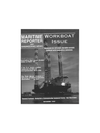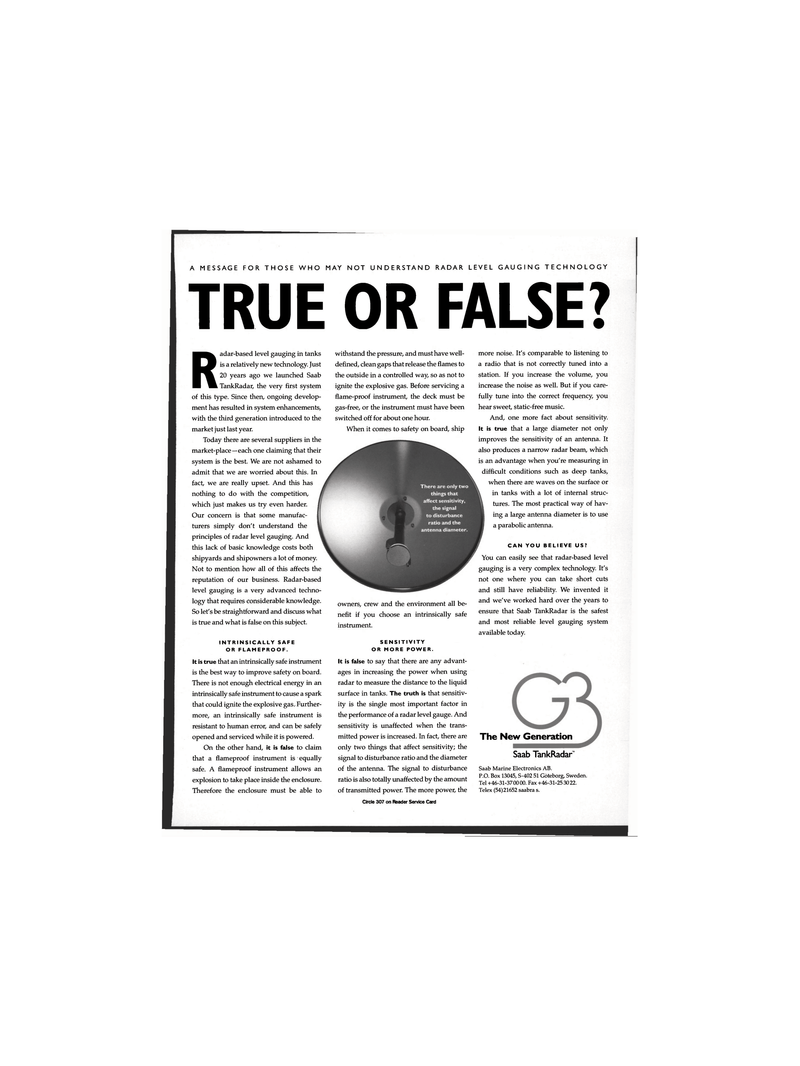
Page 29: of Maritime Reporter Magazine (November 1995)
Read this page in Pdf, Flash or Html5 edition of November 1995 Maritime Reporter Magazine
A MESSAGE FOR THOSE WHO MAY NOT UNDERSTAND RADAR LEVEL GAUGING TECHNOLOGY
TRUE OR FALSE?
Radar-based level gauging in tanks is a relatively new technology. Just 20 years ago we launched Saab TankRadar, the very first system of this type. Since then, ongoing develop- ment has resulted in system enhancements, with the third generation introduced to the market just last year.
Today there are several suppliers in the market-place—each one claiming that their system is the best. We are not ashamed to admit that we are worried about this. In fact, we are really upset. And this has nothing to do with the competition, which just makes us try even harder.
Our concern is that some manufac- turers simply don't understand the principles of radar level gauging. And this lack of basic knowledge costs both shipyards and shipowners a lot of money.
Not to mention how all of this affects the reputation of our business. Radar-based level gauging is a very advanced techno- logy that requires considerable knowledge.
So let's be straightforward and discuss what is true and what is false on this subject.
INTRINSICALLY SAFE
OR FLAMEPROOF.
It is true that an intrinsically safe instrument is the best way to improve safety on board.
There is not enough electrical energy in an intrinsically safe instrument to cause a spark that could ignite the explosive gas. Further- more, an intrinsically safe instrument is resistant to human error, and can be safely opened and serviced while it is powered.
On the other hand, it is false to claim that a flameproof instrument is equally safe. A flameproof instrument allows an explosion to take place inside the enclosure.
Therefore the enclosure must be able to withstand the pressure, and must have well- defined, clean gaps that release the flames to the outside in a controlled way, so as not to ignite the explosive gas. Before servicing a flame-proof instrument, the deck must be gas-free, or the instrument must have been switched off for about one hour.
When it comes to safety on board, ship owners, crew and the environment all be- nefit if you choose an intrinsically safe instrument.
SENSITIVITY
OR MORE POWER.
It is false to say that there are any advant- ages in increasing the power when using radar to measure the distance to the liquid surface in tanks. The truth is that sensitiv- ity is the single most important factor in the performance of a radar level gauge. And sensitivity is unaffected when the trans- mitted power is increased. In fact, there are only two things that affect sensitivity; the signal to disturbance ratio and the diameter of the antenna. The signal to disturbance ratio is also totally unaffected by the amount of transmitted power. The more power, the
Circle 307 on Reader Service Card more noise. It's comparable to listening to a radio that is not correctly tuned into a station. If you increase the volume, you increase the noise as well. But if you care- fully tune into the correct frequency, you hear sweet, static-free music.
And, one more fact about sensitivity.
It is true that a large diameter not only improves the sensitivity of an antenna. It also produces a narrow radar beam, which is an advantage when you're measuring in difficult conditions such as deep tanks, when there are waves on the surface or in tanks with a lot of internal struc- tures. The most practical way of hav- ing a large antenna diameter is to use a parabolic antenna.
CAN YOU BELIEVE US?
You can easily see that radar-based level gauging is a very complex technology. It's not one where you can take short cuts and still have reliability. We invented it and we've worked hard over the years to ensure that Saab TankRadar is the safest and most reliable level gauging system available today.
The New Generation
Saab TankRadar
Saab Marine Electronics AB.
P.O. Box 13045, S-402 51 Goteborg, Sweden.
Tel +46-31-370000. Fax +46-31-253022.
Telex (54)21652 saabra s.

 28
28

 30
30
